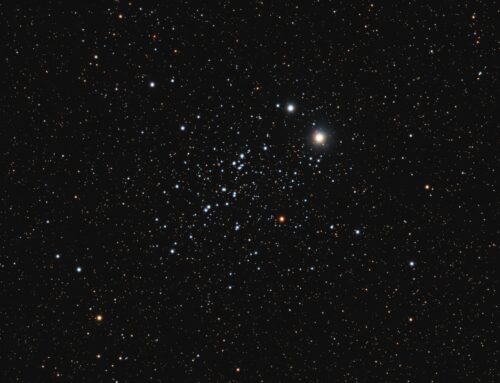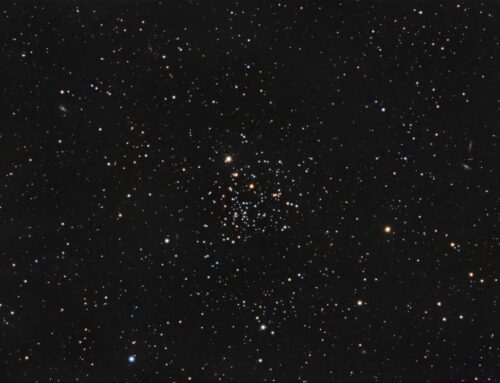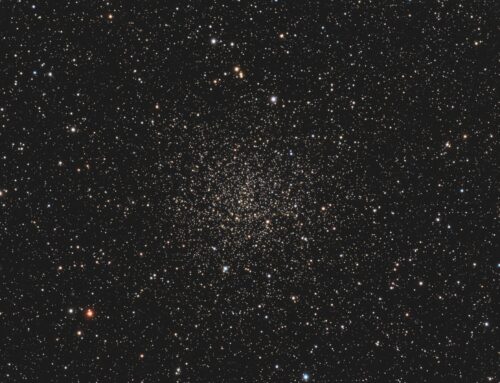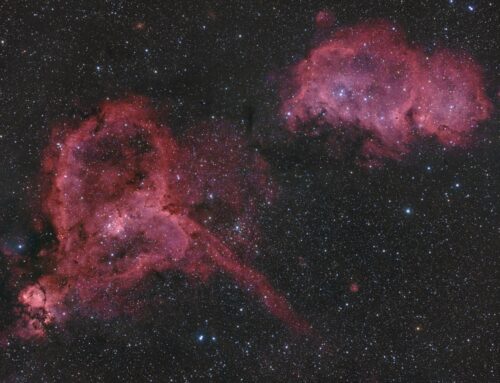M67 Open Cluster
 Click image for full size version
Click image for full size version
April 18, 2020
There are two nice open clusters in Cancer. M67, shown here, is more compact and, to me appears richer than, M44 (the Beehive Cluster) in images. But M44 is usually the “showpiece object” that beginners turn to in this part of the sky. M67’s stars show lots of colour variation. I find it challenging to tell where the cluster actually ends and “background star field” begins.
M67 is thought to be about 4 billion years old, implying that its stars are younger than the Sun. The cluster’s mass is about 1080 times that of the Sun and it lies around 2,750 light years away. It has a radius of about 10 light years and appears to be about the size of the full Moon on the sky.
There are many galaxies also visible in this image. I have posted an annotated image from 2017 that shows some of them (from a previous image of this cluster published in the June 2017 Sky & Telescope).
Tekkies:
Luminance: Sky-Watcher Esprit 150 f/7 refractor and QHY 16200-A camera with Optolong L filter
Chrominance: Takahashi FSQ-106 ED IV @ f/3.6 and QHY367C one-shot colour camera with Optolong L-Pro filter
Chrominance: 88 x 3m = 4hr24m
Total: 8hr09m
Data Reduction and Processing
Preprocessing: The WeightedBatchPreProcessing script was used to create a Luminance master frame (from the mono camera) and a RGB master frame (from the one-shot colour camera). A drizzled RGB master was made using DrizzleIntegration.
Gradient Removal: DBE was applied to L and RGB masters using Subtraction.
Colour
Channel Registration: To improve channel registration, the colour channels of the RGB master were extracted and aligned with StarAlignment, using Thin Plate Splines with Distortion Correction and the green channel as the reference frame. The registered colour channels were recombined with ChannelCombination.
Colour Balancing: Colour was balanced with ColorCalibration.
Linear Noise Reduction: MultiscaleLinearTransform was used to reduce noise in the background areas, using an internal mask to protect bright structures. Layer settings for threshold and strength: Layer 1: 5.0 0.85, 2 iterations; Layer 2: 3.5, 0.75, 2 iterations; Layer 3: 3.0, 0.5, 1 iteration; Layer 4: 1.0, 0.25, 1 iteration.
Stretching: HistogramTransformation was applied to make a pleasing, bright image, with background set to an intensity of approximately 0.10.
Lightness
Linear Noise Reduction: MultiscaleLinearTransform was used to reduce noise in the background areas, using an internal mask to protect bright stars. Layer settings for threshold and strength: Layer 1: 3.0 0.85, 1 iterations; Layer 2: 2.0, 0.75, 1 iterations; Layer 3: 1.0, 0.5, 1 iteration.
Stretching: HistogramTransformation was applied to make a pleasing, bright image, with background set to an intensity of approximately 0.10.
Recombining Lightness and Colour Images
Registration of L and RGB: StarAlignment was used to register the RGB master to the L master.
LRGB Combination: The lightness image was applied to the RGB image using LRGBCombination with default settings.
Additional Processing
Nonlinear Noise Reduction: TGVDenoise was used in L*a*b* mode to reduce noise with a mask used to target the background areas and protect the stars (max. 1000 iterations and convergence selected for both lightness and chrominance).
Final Steps: Background and star brightness, contrast, and colour saturation were adjusted in several iterations using CurvesTransformation with masks as required. ICCProfileTransformation (sRGB IEC61966-2.1; Relative Colorimetric with black point compensation) was applied prior to saving as a jpg.






Very nice Ron. Thank you for the processing explanation.
You’re welcome!